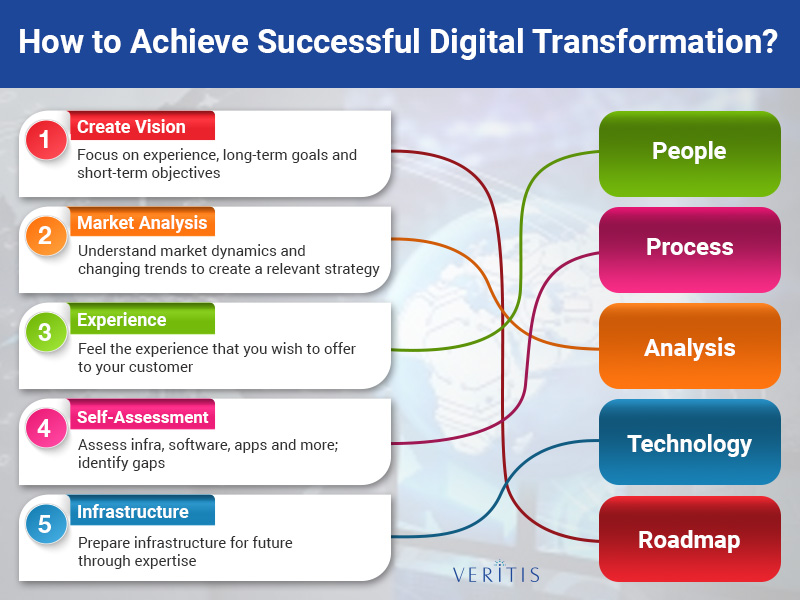
To meet the ever-growing consumer demands, every industry is looking for an all-round transformation in their core business functioning.
And, the answer they found is ‘Digital Transformation (DX)’.
Transforming digitally means bringing in a complete change in the way business and operations function by empowering them with digital capabilities.
More than a technology solution, DX is all about adopting a next-gen business culture.
But achieving that transformation is not an easy process.
Like any other implementation, a successful digital transformation process requires a 5–Step Approach and a well-defined Roadmap.
Here are 5 Steps that decide the success of your DX/DT Strategy:
1) Set Vision

Setting up a vision is the first step to any process and the same for digital transformation. With the prime focus on experience, the DX vision strategy should ideally include long-term goals and short-term objectives.
Build your vision on the available resources rather than working out on innovations. Identify gaps and plan a realistic roadmap for implementations.
2) Market Analysis

Remember! You are in the race for next-gen transformation. So, it’s very important to understand the market dynamics and changing trends. This helps you create an up-to-date and relevant strategy that matches the industry competition.
Nothing to worry! The right inspiration could be around you in your own industry. All you need is a keen observation to changing market trends.
3) Feel the Experience

Considering the reality that DX is all about the end-user experience, you should first feel the experience that you wish to offer to your customer. That’s where the success lies in DX.
Even market surveys say that more than 90 percent of success in DX business depends on customers’ as well as employees’ digital experiences. Success in DX strategy lies in ‘how appealing and easy you make your offering to your customers’.
4) Self-assessment

While the first three steps lay the path for your DX strategy, this step tells where you stand in the journey. In this step, you will have to identify gaps and take the necessary gaps to fill them.
Understand your current infrastructure, software, apps and more, and check their feasibility to future changes you make through DX. Don’t forget to identify key supporting, developmental areas and make necessary integrations as part of your DX strategy.
5) Manage Infrastructure

Last, but crucial step! This step involves monitoring and preparing the existing infrastructure for the all-new transformation. For this, you will definitely need an expert team of CIO, CDO and other qualified DX specialists.
If not in-house experts, its time you should think of hiring a reliable partner or a consultant who can help you in DX implementation. Besides, it’s also important to keep your internal teams upgraded with the skillset that the new transformation demands, by way of training, certifications and more.
Also Read: Digital Transformation Services and Solutions
Above everything, DX is a culture transformation!

Digital Transformation Roadmap
We have seen the steps that decide the success of DX strategy and now we will see a DX/DT Roadmap that lays down the path for a successful DX journey.
Digital Roadmap forms the basis to define and manage digital transformation efforts through a well-defined path.
4 Factors that makeup Digital Transformation Roadmap include:
1) People

Establishing a customer-centric culture stands key to achieving the core goal of DX i.e. enhanced customer experience.
This involves personalizing buyer engagement with the brand through cross-team collaboration.
2) Process

Understanding the customer lifecycle is very important to design the experience. Maximize organizational efficiency and enhance scalability for the new business transformation, while creating contextualized marketing plans that can effectively carry your brand to the customer. Analyze internal processes, data, and workflows, and apply business intelligence for better productivity.
3) Technology

Developing an information architecture plays a very crucial role in driving digital transformation. This infrastructure serves as a basis for the integration of data siloes, information management and data analytics. Also, helps in the structuring of data and content for establishing relationships between classes of information. Remember! The architecture should reflect your core business landscape.
4) Content

This is where the information is organized in line with customer expectations, managing both enterprise and end-user targeted information in parallel. The planned content should be aligned with data governance, quality and should be well-organized, accurate, easily findable, personalized and contextual.
These factors should be checked across all digital assets to ensure that the content reaches the buyer as expected. Search strategies have to be applied to make it easily findable for a targeted user. Don’t forget to track ROI across this multi-channel approach.
Above everything, DX is a cultural transformation!
The Conclusion
The market demand for Digital Transformation (DX) is so high that the surveys expect DX spending to go up to USD 1.8 trillion in 2019 and further to USD 6 trillion by 2022, irrespective of industry.
Want to tap the opportunity?
